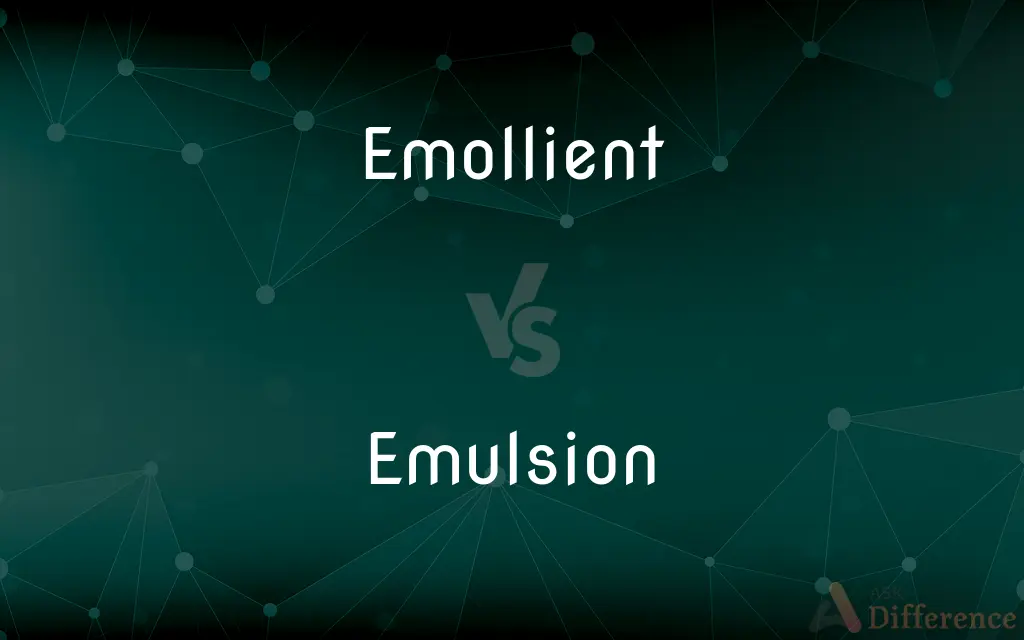Emollient vs. Emulsion — What's the Difference?
Edited by Tayyaba Rehman — By Urooj Arif — Updated on March 28, 2024
Emollients soften and soothe the skin, whereas emulsions are mixtures of water and oil, stabilized by an emulsifier.

Difference Between Emollient and Emulsion
Table of Contents
ADVERTISEMENT
Key Differences
Emollients are primarily used to moisturize and soften the skin by forming an occlusive barrier that prevents moisture loss. These are ingredients found in many skincare products like creams and lotions, designed to improve skin texture and health. On the other hand, emulsions are a type of formulation that combines water and oil phases to create a unified product. Emulsions require an emulsifier to keep the mixture stable and prevent the oil and water from separating.
While emollients can be a single ingredient aimed at reducing skin dryness or irritation, emulsions are complex formulations that can serve multiple purposes, such as hydrating, nourishing, or even cleansing the skin. Emulsions can contain emollients within their formulation, blending the moisturizing benefits with other properties.
Emollients work by filling the gaps between skin cells, making the skin feel smoother and softer. They are often recommended for managing dry skin conditions, like eczema and psoriasis. Emulsions, on the other hand, can be designed for a variety of skin types and conditions, offering hydration without being too heavy for oily skin or providing rich nourishment for dry skin.
Another key difference is in the application and feel on the skin. Emollients tend to be richer and thicker, providing a protective layer on the skin's surface. Emulsions are generally lighter and absorb more quickly, making them suitable for use under makeup or for individuals with oily or combination skin types.
The choice between an emollient and an emulsion depends on the individual's skin needs and preferences. Those with very dry or sensitive skin may benefit more from direct emollient applications, whereas those looking for a balanced moisturizer that doesn’t feel heavy might prefer an emulsion.
ADVERTISEMENT
Comparison Chart
Definition
Ingredients that soften and soothe the skin.
Mixtures of oil and water stabilized by an emulsifier.
Primary Use
To moisturize and protect the skin.
To combine oil and water into a stable product for various skin benefits.
Texture
Typically thicker and more occlusive.
Lighter and more absorbent.
Skin Types
Ideal for dry and sensitive skin.
Suitable for all skin types, including oily and combination.
Examples
Shea butter, lanolin.
Lotions, creams, and cleansing milks.
Compare with Definitions
Emollient
Used to improve skin texture.
Jojoba oil is an emollient that enhances skin smoothness.
Emulsion
Requires an emulsifier to stay mixed.
Lecithin is a natural emulsifier used in food and cosmetic emulsions.
Emollient
Substance that softens or soothes the skin.
Glycerin is a common emollient used in skincare products.
Emulsion
Suitable for a variety of skincare products.
Cleansing milks are emulsions designed to remove makeup gently.
Emollient
Can be used in medical creams.
Emollient creams are often prescribed for eczema treatment.
Emulsion
A stable blend of oil and water.
Most facial creams are emulsions, providing hydration and nourishment.
Emollient
Part of daily skincare routines.
Adding an emollient to your nighttime routine can prevent dry skin.
Emulsion
Offers hydration without heaviness.
Lightweight emulsions are preferred for daytime moisturizing.
Emollient
Ingredients that prevent moisture loss.
Lanolin in lip balm acts as an emollient, keeping lips hydrated.
Emulsion
Can be water-in-oil or oil-in-water.
Sunscreen lotions are often oil-in-water emulsions for a lighter feel.
Emollient
Softening and soothing, especially to the skin.
Emulsion
An emulsion is a mixture of two or more liquids that are normally immiscible (unmixable or unblendable) owing to liquid-liquid phase separation. Emulsions are part of a more general class of two-phase systems of matter called colloids.
Emollient
Making less harsh or abrasive; mollifying
The emollient approach of a diplomatic mediator.
Emulsion
A fine dispersion of minute droplets of one liquid in another in which it is not soluble or miscible
Oil beaten to an emulsion with a half tablespoonful of vinegar
Emollient
An agent that softens or soothes the skin.
Emulsion
A type of paint used for walls, consisting of pigment bound in a synthetic resin which forms an emulsion with water
Three coats of white emulsion
Emollient
An agent that assuages or mollifies.
Emulsion
Paint with emulsion
If the lining paper is not opaque, the wall should also be emulsioned
Emollient
Something which softens or lubricates the skin; moisturizer.
Emulsion
A suspension of small globules of one liquid in a second liquid with which the first will not mix
An emulsion of oil in vinegar.
Emollient
(figurative) Anything soothing the mind, or that makes something more acceptable.
Emulsion
A photosensitive coating, usually of silver halide grains in a thin gelatin layer, on photographic film, paper, or glass.
Emollient
Moisturizing.
Emulsion
A stable suspension of small droplets of one liquid in another with which it is immiscible.
Mayonnaise is an emulsion where egg is used to keep oil and water mixed.
Emollient
(figurative) Soothing or mollifying.
Emulsion
(chemistry) A colloid in which both phases are liquid.
Emollient
Softening; making supple; acting as an emollient.
Emulsion
(photography) The coating of photosensitive silver halide grains in a thin gelatine layer on a photographic film.
Emollient
An external something or soothing application to allay irritation, soreness, etc.
Emulsion
Any liquid preparation of a color and consistency resembling milk; as: (a) In pharmacy, an extract of seeds, or a mixture of oil and water united by a mucilaginous substance. (b) In photography, a liquid preparation of collodion holding salt of silver, used in the photographic process.
Emollient
Toiletry consisting of any of various substances resembling cream that have a soothing and moisturizing effect when applied to the skin
Emulsion
(chemistry) a colloid in which both phases are liquids;
An oil-in-water emulsion
Emollient
Having a softening or soothing effect especially to the skin
Emulsion
A light-sensitive coating on paper or film; consists of fine grains of silver bromide suspended in a gelatin
Common Curiosities
What are emulsions?
Emulsions are mixtures of oil and water components stabilized by an emulsifier to form a cohesive product.
Can emulsions contain emollients?
Yes, many emulsions include emollients in their formulations to enhance moisturizing properties.
What are emollients?
Emollients are substances that soften and soothe the skin by forming a protective layer to prevent moisture loss.
How do I choose between an emollient and an emulsion?
Consider your skin type and needs; emollients for intense moisture and protection, emulsions for balanced hydration.
Can I use both an emollient and an emulsion?
Yes, they can be used together in a skincare routine for enhanced moisturizing effects.
Are emulsions suitable for oily skin?
Yes, especially oil-in-water emulsions, as they provide hydration without adding excess oil.
What is the best time to apply emollients?
After bathing or showering when the skin is still slightly damp to lock in moisture.
Why do emulsions need an emulsifier?
Emulsifiers prevent the oil and water components from separating, ensuring a stable and uniform mixture.
Can emollients help with eczema?
Absolutely, emollients are often recommended for managing eczema by keeping the skin moisturized and reducing irritation.
How do emollients benefit the skin?
They moisturize the skin, fill gaps between skin cells, and help to soothe and protect dry or irritated skin.
What is the main purpose of an emulsion in skincare?
Emulsions combine hydrating and nourishing ingredients in a lightweight formula suitable for various skin types.
Are emollients only for dry skin?
Primarily, but they can also benefit normal to sensitive skin, especially in harsh weather conditions.
What makes an emulsion different from a lotion?
A lotion is a type of emulsion with a particular texture and use, often lighter and more fluid.
How are emulsions applied to the skin?
Like any skincare product, with gentle massaging to ensure even distribution and absorption.
Do emulsions have a specific shelf life?
Yes, like all skincare products, emulsions have a shelf life, typically indicated on the packaging, and should be used within this timeframe to ensure efficacy.
Share Your Discovery

Previous Comparison
Choristoma vs. Hamartoma
Next Comparison
Spatha vs. GladiusAuthor Spotlight
Written by
Urooj ArifUrooj is a skilled content writer at Ask Difference, known for her exceptional ability to simplify complex topics into engaging and informative content. With a passion for research and a flair for clear, concise writing, she consistently delivers articles that resonate with our diverse audience.
Edited by
Tayyaba RehmanTayyaba Rehman is a distinguished writer, currently serving as a primary contributor to askdifference.com. As a researcher in semantics and etymology, Tayyaba's passion for the complexity of languages and their distinctions has found a perfect home on the platform. Tayyaba delves into the intricacies of language, distinguishing between commonly confused words and phrases, thereby providing clarity for readers worldwide.














































